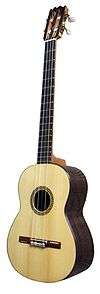Cuatro (instrument)
The cuatro is a family of Latin American string instruments found in Central and South America, Puerto Rico and other parts of the West Indies, derived from the Spanish guitar. Although some have viola-like shapes, most cuatros resemble a small to mid-sized classical guitar.
 Venezuelan Folk Cuatro |
 Venezuelan Concert Cuatro |
Cuatro means four in Spanish; the instrument's 15th century predecessors were the Spanish vihuela and the Portuguese cavaquinho, the latter having four strings like the original cuatro (modern cuatros often have more than four strings).
Certain variants are considered the national instrument of some countries (e.g., Venezuela). The cuatro is widely used in ensembles in Jamaica, Mexico, and Surinam to accompany singing and dancing. In Trinidad and Tobago it accompanies Parang singers. In Saint Lucia the cuatro is used as an accompanying instrument in traditional Sewenal music at Christmas time. In Puerto Rico and Venezuela, the cuatro is an ensemble instrument for secular and religious music, and is played at parties and traditional gatherings.[1]
Modern cuatros come a variety of sizes and shapes, and number of strings. Cuatros can either have single-strings, like a guitar, or double- or triple-coursed strings like a mandolin, and vary in size from a large mandolin or small guitar, to the size of a full-size guitar. Depending on their particular stringing, cuatros are part of the guitar or mandolin subfamilies of the lute family.
Venezuelan cuatro
The cuatro of Venezuela has four single nylon strings, tuned A3 D4 F♯4 B3. It is similar in shape and tuning to the ukulele, but their character and playing technique are vastly different. It is tuned in a similar fashion to the ukulele's traditional D tuning, but the B is an octave lower. Consequently, the same fingering can be used to shape the chords, but it produces a different inversion of each chord. There are variations on this instrument, having 5 strings or 6 strings.
Variants
Other Venezuelan cuatro variants include: cinco cuatro (5 strings in 4 courses); seis cinco (6 strings in 5 courses); cinco y medio (5 strings and a short extra string from the top of the body); cuatro y medio (4 strings plus a short extra string); and octavo (8 strings in 4 double courses).
Puerto Rican cuatros

The Puerto Rican cuatro is shaped more like a viola than a guitar, and is the most familiar of the three instruments of the Puerto Rican orquesta jíbara (i.e., the cuatro, the tiple and the bordonua). The Puerto Rican cuatro has ten strings in five courses, tuned in fourths from low to high, with B and E in octaves and A, D, and G in unisons: B3+B2 E4+E3 A3+A3 D4+D4 G4+G4.
Several sizes of the instrument exist, including a cuatro soprano, cuatro alto, cuatro tradicional (the standard instrument, also called cuatro tenor), and cuatro bajo (bass): All have 10 strings and are tuned in fourths. There is also a cuatro lírico (lyrical cuatro), which is about the size of the tenor, but has a deep jellybean-shaped body; a cuatro sonero, which has 15 strings in 5 courses of 3 strings each; and a seis, which is a cuatro tradicional with an added two-string course (usually a lower course), giving it a total of 12 strings in 6 courses.[2]
Cuatro Cubano
The Cuban cuatro (cuatro Cubano, or tres tuatro), is similar to a Cuban tres, but with 4 courses of doubled strings, instead of the usual 3 courses. It is usually tuned G4+G3 C4+C4 E4+E4 A4+A4.
See also
- Banjo
- Cavaco – a Brazilian instrument very similar to a cuatro.
- Cavaquinho – the Portuguese instrument from which the cavaco was derived.
- Stringed instrument tunings
References
- "C". Stringed Instrument Database. Retrieved 2018-03-20.
- "Interesting". The Puerto Rican Cuatro Project.
- "Instrumentos Musicales de Venezuela: Cuatro". Diccionario Multimedia de Historia de Venezuela. Fundación Polar.
- Fredy Reyna (1994). Alfa Beta Cuatro. Monte Avila Editores.
- Alejandro Bruzual (1999). Fredy Reyna – Ensayo biográfico. Alter Libris.
Further reading
- Tobe A. Richards (2007). The Venezuelan Cuatro Chord Bible: A D F# B Standard Tuning 1,728 Chords. Cabot Books. ISBN 978-1-906207-00-7.
- Tobe A. Richards (2007). The Puerto Rican Cuatro Chord Bible: B E A D G Standard Tuning 1,728 Chords. Cabot Books. ISBN 978-1-906207-06-9.
External links
| Wikimedia Commons has media related to Cuatro. |
- "News and Videos about Venezuelan Cuatro".
- "Material and HD Videos for learning to play Venezuelan Cuatro". Tu Cuatro (English pages). Archived from the original on 2012-09-20. Retrieved 2012-10-15.
- "The Puerto Rican Cuatro Project". The Puerto Rican Cuatro Project.